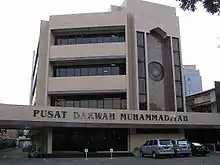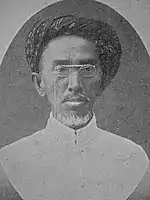Muhammadiyah
Muhammadiyah (Arabic: محمدية, followers of Muhammad; full name: Persyarikatan Muhammadiyah) is a major Islamic non-governmental organization in Indonesia.[1] The organization was founded in 1912 by Ahmad Dahlan in the city of Yogyakarta as a reformist socioreligious movement, advocating ijtihad - individual interpretation of Qur'an and sunnah, as opposed to taqlid - the acceptance of the traditional interpretations propounded by the ulama.[2] Since its establishment, Muhammadiyah has adopted a reformist platform mixing religious and secular education,[3] primarily as a way to promote the upward mobility of Muslims toward a 'modern' community and to purify Indonesian Islam of local syncretic practices.[3] It continues to support local culture and promote religious tolerance in Indonesia, while a few of its higher education institutions are attended mostly by non-Muslims, especially in East Nusa Tenggara and Papua provinces. The group also runs a large chain of charity hospitals,[1] and operated 128 universities as of the late 1990s.[4]
 The logo of Muhammadiyah | |
 Zone of influence | |
| Formation | 18 November 1912 |
|---|---|
| Type | Organization |
| Purpose | Religious Islamic |
| Headquarters | Jl. Cik Dik Tiro, Yogyakarta, Special Region of Yogyakarta, Indonesia |
Region served | Indonesia |
Membership | 50 million |
Leader | Dr. Haedar Nashir |
| Website | Official website |
In 2008, Muhammadiyah was considered the second largest Islamic organization in Indonesia with 29 million members.[2] Although Muhammadiyah leaders and members are often actively involved in shaping the politics in Indonesia, Muhammadiyah is not a political party. It has devoted itself to social and educational activities.
History
On November 18, 1912, Ahmad Dahlan— a court official of the kraton of Yogyakarta[5] and an educated Muslim scholar from Mecca—established Muhammadiyah in Yogyakarta. There were a number of motives behind the establishment of this movement. Among the important ones are the backwardness of Muslim society and the penetration of Christianity. Ahmad Dahlan, much influenced by Egyptian reformist Muhammad Abduh, considered modernization and purification of religion from syncretic practices were very vital in reforming this religion. Therefore, since its beginning Muhammadiyah has been very concerned with maintaining tawhid and refining monotheism in society.
From 1913 to 1918, Muhammadiyah established five Islamic Schools. In 1919 an Islamic high school, Hooge School Muhammadiyah was established.[6] In establishing schools, Muhammadiyah received significant help from the Boedi Oetomo, an important nationalist movement in Indonesia in the first half of the twentieth century, which provided teachers.[7] Muhammadiyah has generally avoided politics. Unlike its traditionalist counterpart, the Nahdatul Ulama, it never formed a political party. Since its establishment, it has devoted itself to educational and social activities.
In 1925, two years after the death of Dahlan, Muhammadiyah only had 4,000 members but had built 55 schools and two clinics in Surabaya and Yogyakarta.[8] After Abdul Karim Amrullah introduced the organisation to the Minangkabau ethnicity, a dynamic Muslim community, Muhammadiyah developed rapidly. In 1938, the organisation claimed 250,000 members, managed its 834 mosques, 31 libraries, 1,774 schools, and 7,630 ulema. The Minangkabau Merchants spread organization to the entire of Indonesia.[9]
During the 1965-66 political turbulence and violence, Muhammadiyah declared that the extermination of the "Gestapu/PKI" (the 30 September Movement and the Indonesian Communist Party) constituted Holy War, a view endorsed by other Islamic groups.[10] (See also: Indonesian killings of 1965-66). During the 1998 "Indonesian reformation", some parts of Muhammadiyah urged the leadership to form a party. Therefore, the leadership, including Muhammadiyah's chairman, Amien Rais, founded the National Mandate Party. Although gaining large support from Muhammadiyah members, this party has no official relationship with Muhammadiyah. The leader of Muhammadiyah said the members of his organisation are free to align themselves with political parties of their choosing, provided such parties have shared values with Muhammadiyah.[11]
In 2008, with 29 million members, Muhammadiyah was the second largest Muslim organization in Indonesia, after Nahdlatul Ulama.
Doctrine
The central doctrine of Muhammadiyah is Sunni Islam. However, it emphasizes the authority of the Qur'an and the Hadiths as supreme Islamic law that serves as the legitimate basis of the interpretation of religious belief and practices. This is contrasted with traditional practices where shariah law is invested in religious schools by ulema. The main focus of the Muhammadiyah movement is to heighten people's sense of moral responsibility, purifying their faith to true Islam.
Muhammadiyah strongly opposes syncretism, where Islam had coalesced with animism (spirit worship) and with Hindu-Buddhist elements that were spread among communities from the pre-Islamic period. Muhammadiyah opposes the tradition of Sufism that allows a Sufi leader (shaykh) to be the formal authority over Muslims. As of 2006, the organization was said to have "veered sharply toward a more conservative brand of Islam" under the leadership of Din Syamsuddin the head of the Indonesian Ulema Council.[12]
Activities

Muhammadiyah was noted as a Muslim reformists organization. Its main activities are religious practice and education. It has built modern Islamic schools, differing from traditional pesantren. Some of its schools are also open to non-Muslims.[13] In 2006 there were around 5,754 schools owned by Muhammadiyah.[14]
It also functioned as a charitable organization involved in health care. In 2016, it owned several hundred non-profit medical clinics and hospitals across Indonesia.[1] In 2006, it was active in campaigning about the danger of bird flu in Indonesia.[15]
Organization

The national headquarters was originally in Yogyakarta. However, by 1970 the committees dealing with education, economics, health and social welfare had been relocated to the national capital, Jakarta.[16]
Muhammadiyah is supported by several autonomous organizations:[17]
- Aisyiyah ( Women )
- Pemuda Muhammadiyah ( Youth )
- Nasyiatul Aisyiyah ( Young Women )
- Ikatan Pelajar Muhammadiyah ( Student association )
- Ikatan Mahasiswa Muhammadiyah ( College students )
- Tapak Suci Putra Muhammadiyah ( Pencak Silat martial arts )
- Hizbul Wathan ( Scouting ).
The central committee structure consists of five advisors, a chairman with several deputies, a vice chairman, a secretary general with some deputies, and a treasurer with some deputies.[18]
List of leaders
| Number | Photo | Name | Term Start | Term End | Deliberation Place | Description |
|---|---|---|---|---|---|---|
| 1. |  | K.H. Ahmad Dahlan | 1 August 1912 | 23 February 1923 | Yogyakarta | Meetings 1st Year |
| 2. | K.H. Ibrahim | 23 February 1923 | 13 October 1932 | Yogyakarta | Meetings 12th Year | |
| 3. | K.H. Hisyam | 10 November 1934 | 20 May 1936 | Yogyakarta | Meetings 23rd Year | |
| 4. | K.H. Mas Mansur | 25 June 1937 | 25 April 1942 | Yogyakarta | Meetings 26th Year | |
| 5. | Ki Bagoes Hadikoesoemo | 24 November 1944 | 4 November 1953 | Yogyakarta | Emergency Congress | |
| 6. | Buya A.R. Sutan Mansur | 4 November 1953 | 25 March 1959 | Purwokerto | The 32nd Congress | |
| 7. | K.H. M. Yunus Anis | 25 March 1959 | 3 June 1962 | Palembang | The 34th Congress | |
| 8. | K.H. Ahmad Badawi | 3 June 1962 | 25 April 1968 | Jakarta | The 35th Congress | |
| 9. |  | K.H. Faqih Usman | 25 April 1968 | 3 October 1968 | Palembang | The 34th Congress |
| 10. | K.H. Abdul Rozak Fachruddin | 3 October 1968 | 17 March 1971 | Fait Accompli | ||
| 17 March 1971 | 15 December 1990 | Makasar | The 38th Congress | |||
| 11. | K.H. Ahmad Azhar Basyir | 15 December 1990 | 28 June 1995 | Yogyakarta | The 42nd Congress | |
| 12. |  Amien Rais and Abdurrahman Wahid | Prof. Dr. H. Amien Rais | 28 June 1995 | 26 April 1998 | Banda Aceh | The 43rd Congress |
| 13. | Prof. Dr. H. Ahmad Syafi'i Ma'arif | 26 April 1998 | 31 May 2000 | Tanwir & Meetings Plenary Session | ||
| 31 May 2000 | 25 November 2005 | Jakarta | The 44th Congress | |||
| 14. | Prof. Dr. K.H. Din Syamsuddin, M.A. | 31 August 2005 | 8 July 2010 | Malang | The 45th Congress | |
| 8 July 2010 | 6 May 2015 | Yogyakarta | The 46th Congress | |||
| 15. | Dr. K.H. Haedar Nashir | 7 May 2015 | Incumbent | Makassar | The 47th Congress |
Universities
The Muhammadiyah organisation has a number of universities which are spread out in several provinces of Indonesia, such as:
- Ahmad Dahlan University of Yogyakarta (UAD)
- Muhammadiyah University of Malang (UMM)
- Muhammadiyah University of Yogyakarta (UMY)
- Muhammadiyah University of Surakarta (UMS)
- Muhammadiyah University of Purwokerto
- Muhammadiyah University of Makassar (Unismuh)
- Muhammadiyah University of Magelang (UMMGL)
- Muhammadiyah University of Semarang
- Muhammadiyah University of Metro
- Muhammadiyah University of Palembang
- Muhammadiyah University of Bengkulu
- Muhammadiyah University of West Sumatra
- Muhammadiyah University of North Sumatra
- Muhammadiyah University of Aceh
- Muhammadiyah University of Cirebon
- Muhammadiyah University of Bekasi
- Muhammadiyah University of Purworejo
- Muhammadiyah University of Surabaya
- Muhammadiyah University of Sidoarjo
- Muhammadiyah University of Gresik
- Muhammadiyah University of Jember
- Muhammadiyah University of Kupang
- Muhammadiyah University of Ternate
- Muhammadiyah University of Gorontalo
- Muhammadiyah University of Jakarta
- Muhammadiyah University of Prof. Hamka (UHAMKA)
- Muhammadiyah University of Parepare
- Muhammadiyah University of Sukabumi
- Muhammadiyah University of Ponorogo
- Muhammadiyah University of Pontianak
- Muhammadiyah University of Sorong, Papua
See also
References
- A. Jalil Hamid, Tackle the rising cost of living longer . New Straits Times, 30 October 2016. Accessed 1 November 2016.
- "Muhammadiyah". Div. of Religion and Philosophy, St. Martin College, UK. Archived from the original on 2008-09-14. Retrieved 2008-08-28.
- Abu Zayd, Nasr (2006). Reformation of Islamic Thought. Amsterdam University Press. ISBN 9789053568286. Retrieved 20 April 2016.
- Pieternella van Doorn-Harder, WOMEN SHAPING ISLAM: Reading the Qu'ran in Indonesia, pg .95. Champaign: University of Illinois Press, 2010. ISBN 9780252092718
- Burhani (2005), p. 101.
- "Short History of Persyarikatan Muhammadiyah". Muhammadiyah. Archived from the original on 2007-03-19. Retrieved 2006-08-10.
- Burhani (2010), pp. 65-66
- Ricklefs, M.C. (1991). A History of Modern Indonesia 1200-2004. London: MacMillan. p. 356.
- Ricklefs, M.C. (1991). A History of Modern Indonesia 1200-2004. London: MacMillan. p. 357.
- Ricklefs (1991), p. 288.
- "Muhammadiyah Makes Overtures to Islamists". Indonesia Matters. Retrieved 2006-08-10.
- In Indonesia, Islam loves democracy| Michael Vatikiotis | New York Times |6 February 6, 2006
- "USINDO Roundtable With the Muhammadiyah and Aisyiyah Delegation". The US-Indonesian Society. Archived from the original on August 13, 2006. Retrieved 2006-08-10.
- "Muhammadiyah urged Governot to Set Model School". Tribun Timur. Archived from the original on 2007-09-27. Retrieved 2006-08-10.
- "Muhammadiyah to help campaign on danger of avian flu". Antara. Retrieved 2006-08-10.
- "Profil Muhammadiyah".
- "Autonomous Organizations". Muhammadiyah. Archived from the original on 2007-09-27. Retrieved 2006-08-10.
- "Central Organization". Muhammadiyah. Archived from the original on 2007-03-24. Retrieved 2006-08-10.
External links
- Official website
- Official magazine
- Pacific Affairs, Vol. 27, No. 3 (Sep., 1954), pp. 255-263 Modern Islam in Indonesia: The Muhammadiyah After Independence
- Ali Shodiqin, Mochammad. 2014. "Muhammadiyah itu NU!: Dokumen Fiqh yang Terlupakan". Jakarta: NouraBooks.
- Burhani, Ahmad Najib. 2005. "Revealing the Neglected Missions: Some Comments on the Javanese Elements of Muhammadiyah Reformism." Studia Islamika, 12 (1): 101–129.
- Burhani, Ahmad Najib. 2010. Muhammadiyah Jawa. Jakarta: Al-Wasat.
- Peacock, J.L. (1978). Purifying the Faith: The Muhammadijah Movement in Indonesian Islam. Cummings Press.
- "Muhammadiyah". Div. of Religion and Philosophy, St. Martin College, UK. Archived from the original on 2008-09-14. Retrieved 2006-08-28.
- Ricklefs, M.C. 1991. A History of Modern Indonesia since c.1300. 2nd Edition, Stanford: Stanford University Press. ISBN 0-333-57690-X
